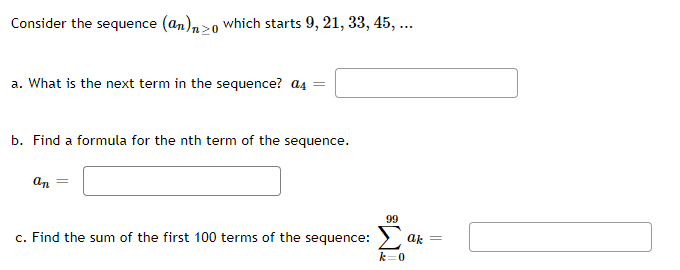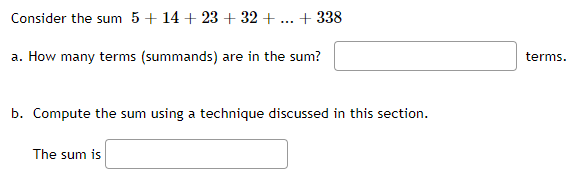Question
Consider the sequence 4, 7, 10, 13, 16, ... with a = = 4 a. Give a recursive definition for the sequence. Select the



Consider the sequence 4, 7, 10, 13, 16, ... with a = = 4 a. Give a recursive definition for the sequence. Select the variable names from the Vars box to use in your definition. an b. Give a closed formula for the nth term of the sequence. an = c. Is 2017 a term in the sequence?? d. How many terms does the sequence 4, 7, 10, 13, 16, ..., 322 have? e. Find the sum 4 +7+10 +13 +16 + bn + 322. f. Use what you found above to find bn, the nth term of 1, 2, 7, 16, 29, ... where bo = 1 = terms Consider the sequence (an)nzo which starts 9, 21, 33, 45, ... a. What is the next term in the sequence? a4 b. Find a formula for the nth term of the sequence. an c. Find the sum of the first 100 terms of the sequence: 99 k=0 ak = Consider the sum 5+14+23 + 32 + + 338 a. How many terms (summands) are in the sum? b. Compute the sum using a technique discussed in this section. The sum is terms.
Step by Step Solution
There are 3 Steps involved in it
Step: 1

Get Instant Access to Expert-Tailored Solutions
See step-by-step solutions with expert insights and AI powered tools for academic success
Step: 2

Step: 3

Ace Your Homework with AI
Get the answers you need in no time with our AI-driven, step-by-step assistance
Get StartedRecommended Textbook for
Income Tax Fundamentals 2013
Authors: Gerald E. Whittenburg, Martha Altus Buller, Steven L Gill
31st Edition
1111972516, 978-1285586618, 1285586611, 978-1285613109, 978-1111972516
Students also viewed these Mathematics questions
Question
Answered: 1 week ago
Question
Answered: 1 week ago
Question
Answered: 1 week ago
Question
Answered: 1 week ago
Question
Answered: 1 week ago
Question
Answered: 1 week ago
Question
Answered: 1 week ago
Question
Answered: 1 week ago
Question
Answered: 1 week ago
Question
Answered: 1 week ago
Question
Answered: 1 week ago
Question
Answered: 1 week ago
Question
Answered: 1 week ago
Question
Answered: 1 week ago
Question
Answered: 1 week ago
Question
Answered: 1 week ago
Question
Answered: 1 week ago
Question
Answered: 1 week ago
Question
Answered: 1 week ago
Question
Answered: 1 week ago
Question
Answered: 1 week ago
Question
Answered: 1 week ago
View Answer in SolutionInn App



